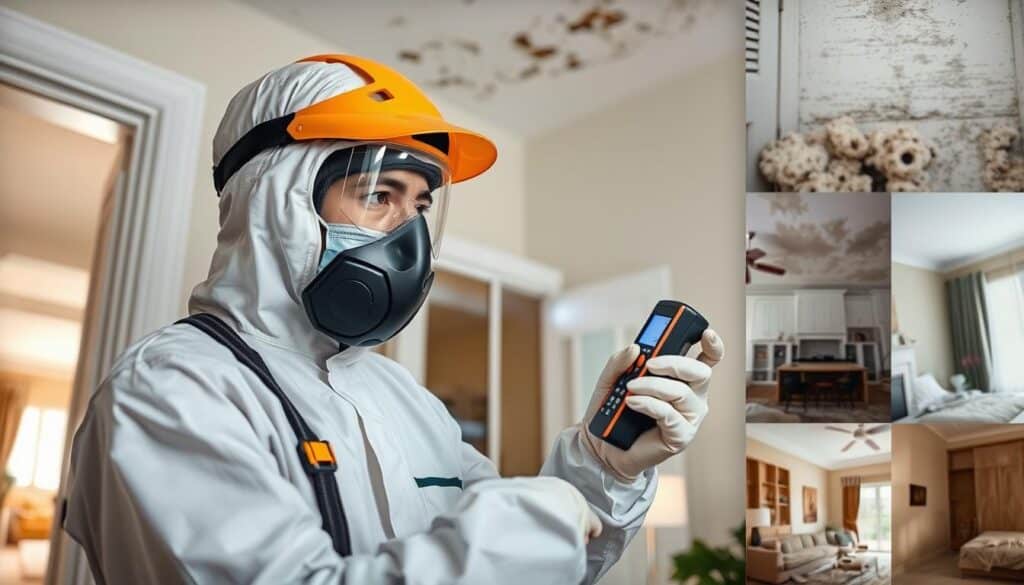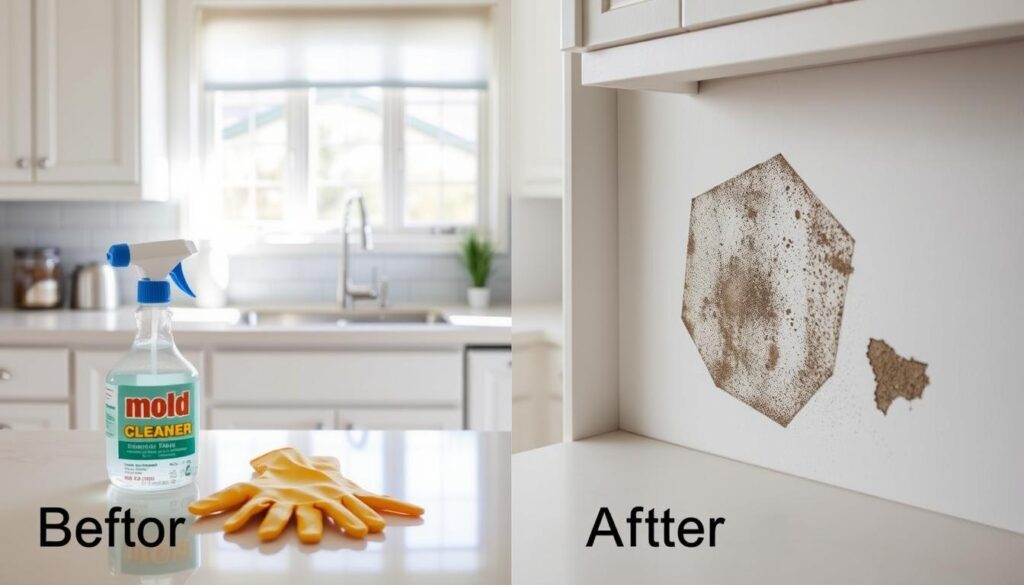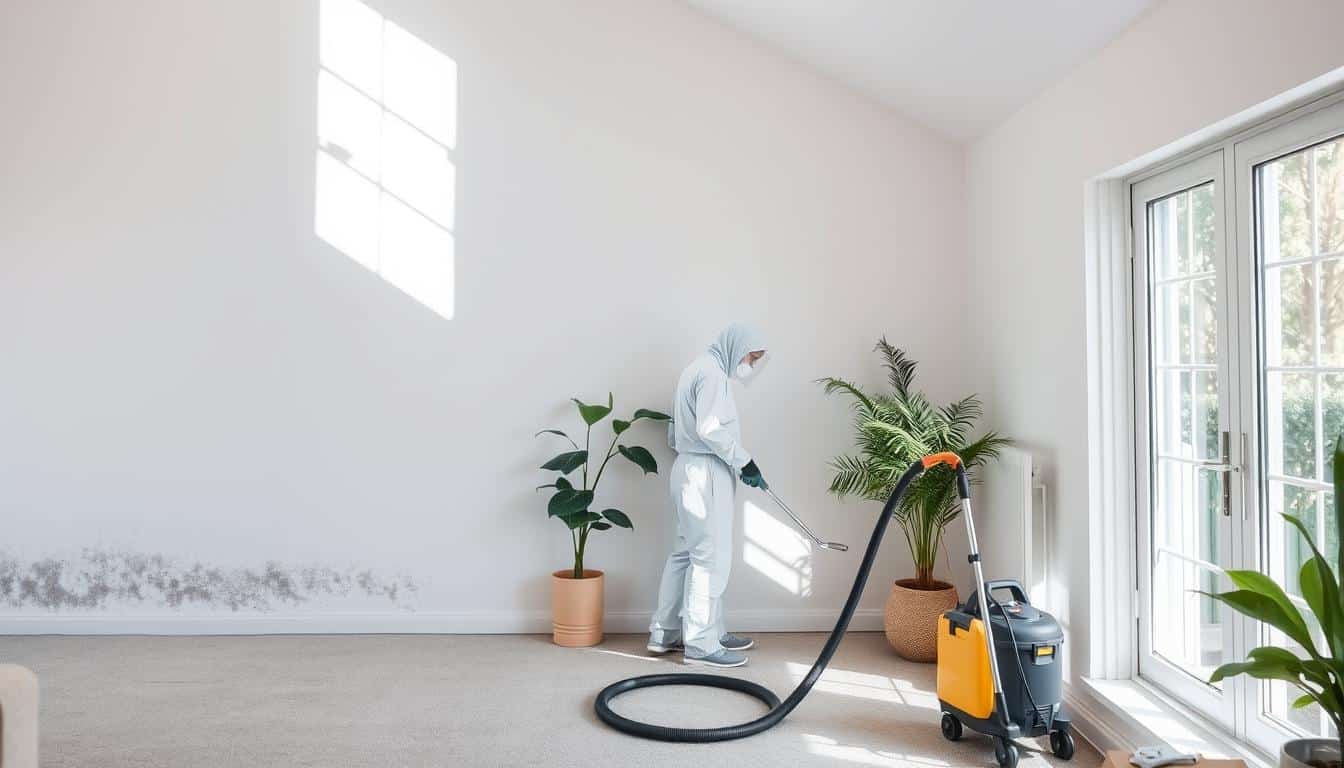Did you know mold can grow in your home in just 24 to 72 hours? This fact shows how fast mold can spread. Mold can grow on many surfaces, like wood, paper, carpet, and even food. This made me look into how to remove mold safely and improve the air inside.
Mold isn’t just ugly; it’s harmful to the air inside your home. If not dealt with, it can damage your property and harm your family’s health. So, I’m eager to share some safe and effective ways to remove mold from your home.
When dealing with mold, time is very important. Acting fast can reduce damage and keep your life less disrupted. Professional mold removal services, like those certified by the Institute of Inspection Cleaning and Restoration Certification (IICRC), are very helpful for big mold problems.
But for small mold issues, you can try some DIY methods. I’ve used vinegar or baking soda for small mold cleanups. Always remember to protect yourself – wear a mask, gloves, and goggles when dealing with mold.
Key Takeaways
- Mold can grow significantly within 24-72 hours in moist conditions
- Quick response is crucial to minimize damage and disruption
- Professional mold remediation services are certified and equipped for severe cases
- DIY methods using natural solutions can be effective for minor mold issues
- Proper protective gear is essential when dealing with mold
Understanding Residential Mold: Causes and Risks
Mold in homes is a common issue that can lead to serious health problems and property damage. I’ll explore the root causes of mold growth, its health impacts, and how to spot it in your living space.
Common causes of indoor mold growth
Excess moisture is the primary culprit behind mold growth. In my experience, the most frequent sources include roof leaks, plumbing issues, and poor ventilation. Damp basements, steam from bathrooms and kitchens, and indoor clothes drying can also create ideal conditions for mold. Effective moisture control is key to preventing these problems.
Health risks associated with mold exposure
Mold exposure can trigger a range of health issues. I’ve found that common symptoms include nasal congestion, eye irritation, coughing, and skin irritation. For people with allergies or respiratory conditions, the effects can be more severe. Mold spores contribute to indoor air pollution, making proper ventilation crucial.
Identifying mold in your home
Spotting mold early is vital for effective remediation. I always look for visible signs like dark spots on walls or ceilings, especially in damp areas. A musty odor is another telltale sign. Regular mold inspection of moisture-prone areas like bathrooms, window sills, and basements can help catch issues early.
- Check for discoloration on surfaces
- Pay attention to musty smells
- Look for signs of water damage
- Inspect areas with high humidity
Remember, mold can grow on various materials, including wood, drywall, and fabrics. If you suspect a mold problem, it’s best to address it quickly to prevent further spread and potential health risks.
The Importance of Professional Mold Assessment
Professional mold assessment is key to a healthy home. Mold can be hard to find and even harder to get rid of. That’s why expert mold testing is vital for correct diagnosis and treatment.
Experts do a detailed check of your home during an assessment. They use tools like moisture meters and infrared cameras to find hidden mold. This is something you can’t do on your own.

Air quality testing is also important in mold assessment. Professionals take air samples to check mold spore levels. This helps them understand your home’s air quality and plan the best treatment.
Early detection and remediation prevent escalation of mold infestations and potential structural damage.
A full mold inspection includes:
- Identifying moisture sources
- Evaluating the extent of mold growth
- Assessing potential health risks
- Recommending appropriate remediation strategies
Assessors give detailed reports with their findings and treatment suggestions. This is very helpful in solving mold problems and stopping them from coming back.
| Benefits of Professional Mold Assessment | DIY Mold Inspection | Professional Mold Inspection |
|---|---|---|
| Accuracy | Limited | High |
| Hidden Mold Detection | Difficult | Advanced tools used |
| Air Quality Testing | Not available | Comprehensive |
| Expert Recommendations | None | Detailed report provided |
By choosing professional mold assessment, you’re making your home safer and healthier. It’s a smart move for keeping your home in good shape. It saves you time, money, and health problems later on.
Preparing for Mold Remediation: Essential Steps
Mold remediation is key to a healthy home. I’ll show you how to get ready for mold removal. We’ll focus on controlling moisture, preventing mold, and improving air quality.
Addressing Moisture Sources
First, we tackle moisture sources. I fix leaks, improve ventilation, and lower humidity. This stops mold from coming back and keeps your home safe from mold.
Isolating Contaminated Areas
Then, I use barriers and negative air pressure to isolate affected areas. This keeps mold spores from spreading. It helps keep your home’s air clean.
Removing Damaged Items
Finally, I get rid of moldy items like carpeting and furniture. These are sealed and cleaned before being thrown away. This step is important for removing mold spores.
| Remediation Step | Importance | Impact on Air Quality |
|---|---|---|
| Moisture Control | Prevents future mold growth | Reduces humidity, improves air quality |
| Area Isolation | Prevents spore spread | Maintains clean air in unaffected areas |
| Item Removal | Eliminates mold sources | Removes allergens, enhances overall air quality |
By taking these steps, I prepare your home for mold removal. This ensures a successful cleanup and a healthier living space.
Safe and Effective Mold Cleaning Techniques
When dealing with mold, safety and effectiveness are top priorities. The right mold removal methods not only get rid of visible mold. They also make the air inside cleaner. Let’s look at some effective ways to remove mold.
HEPA Vacuuming
HEPA vacuuming is my first choice for mold cleaning. These vacuums catch tiny mold spores, stopping them from spreading. I vacuum all surfaces, like walls and floors, to get rid of mold particles and improve air quality.

Wet Wiping and Scrubbing
For tough mold, I use wet wiping and scrubbing. On hard surfaces, I scrub with a detergent solution. For soft materials, a damp cloth works best. Always wear gloves and a mask during this step.
Drying Affected Areas
After cleaning, drying is key to stop mold from coming back. I use fans and dehumidifiers to lower moisture. Keeping humidity below 60% helps prevent mold and keeps the air clean.
For big mold problems over 10 square feet, it’s wise to get professional help. They have the skills and tools to safely and effectively handle big mold cases.
Natural Mold Removal Solutions
I’ve found some great natural ways to clean mold that also improve your home’s air. These methods are safe, work well, and are good for the planet.
Vinegar: A powerful mold-fighting agent
Distilled white vinegar is my top choice for fighting mold. It’s amazing – it can handle over 80% of mold types! I apply it undiluted, letting it sit for an hour before cleaning. It works well on many surfaces and helps keep mold away.
Baking soda: Gentle yet effective
Baking soda is another great natural option. I mix it with water to make a paste or spray. It’s great for light mold and absorbs bad smells. Plus, when I mix it with vinegar, it creates bubbles that make it even more effective!
Tea tree oil and other natural alternatives
Tea tree oil is a strong antifungal that I use for tough mold. Other good choices include hydrogen peroxide, lemon juice, and grapefruit seed extract. These natural solutions are safe and easy to find.
| Natural Remedy | Effectiveness | Best For |
|---|---|---|
| Vinegar | High (80% of mold species) | All surfaces |
| Baking Soda | Medium | Mild cases, odor absorption |
| Tea Tree Oil | High | Stubborn mold |
Using these natural solutions, I’ve found that cleaning mold can be both effective and eco-friendly. It helps make the air in my home better.
Residential Mold Removal: Professional vs. DIY Approaches
Homeowners often debate whether to handle mold themselves or call professionals. The decision between DIY and professional mold remediation depends on several factors.
DIY mold removal is good for small areas under 10 square feet. It’s fast and works for minor problems. But, bigger mold issues need a pro’s touch. The U.S. Environmental Protection Agency suggests calling professionals for areas over 10 square feet.
Professional mold removal is thorough and improves air quality. It saves time and lowers health risks from mold. Experts use special tools and methods to remove mold completely.
Professional mold removal is more reliable for larger infestations and toxic black mold.
DIY methods have their limits. They might miss hidden mold or moisture problems. For those with asthma, allergies, or weak immune systems, getting professional help is key. Mold can spread through HVAC systems.
| Aspect | DIY Approach | Professional Approach |
|---|---|---|
| Cost | Lower for small areas | Higher but more comprehensive |
| Effectiveness | Limited to visible mold | Addresses hidden mold and moisture |
| Time | Can be time-consuming | Efficient for larger areas |
| Health Safety | Potential exposure risks | Minimizes health hazards |
| Equipment | Basic household tools | Specialized equipment |
Mold can grow in as little as 48 hours in damp places. Quick action is crucial. For suspected hidden mold or areas over 10 square feet, it’s best to contact professionals for safe and effective mold remediation.
Post-Remediation Steps: Ensuring a Mold-Free Environment
After removing mold, I work to keep my living space clean and healthy. It’s important to take steps to prevent mold and improve air quality. Let’s look at what to do after mold removal.
Final Inspection and Testing
I always do a final check. This includes checking moisture, humidity, and looking for mold. Testing is key to make sure mold is gone. Air samples are taken to check for mold spores.
Restoration and Repairs
After testing shows the area is clean, I start repairs. This might mean replacing drywall, flooring, or insulation. Using mold-resistant products is crucial to stop mold from coming back.
Preventive Measures
Keeping air quality good is important. I take several steps:
- Install dehumidifiers to keep humidity between 30-50%
- Improve ventilation in areas like bathrooms and kitchens
- Regularly clean and dust belongings
- Schedule professional carpet and duct cleaning
- Maintain HVAC systems, plumbing, and roofing
By following these steps, I make my home a place mold can’t thrive. Regular checks and quick action on moisture issues keep my home healthy.
| Surface Type | Cleaning Frequency | Recommended Method |
|---|---|---|
| Porous (upholstery, carpets) | Weekly | HEPA vacuum |
| Non-porous (glass, sealed counters) | 3 times minimum | Damp cloth |
| HVAC system | Bi-annually | Professional cleaning |
Advanced Mold Removal Techniques for Severe Cases
Severe mold infestations need advanced techniques for effective mold remediation and better air quality. These cases require special methods that go beyond simple cleaning.
One important technique is containment. We use negative air pressure systems to stop mold spores from spreading. This keeps the air clean in the home. For hard-to-reach mold, I might use dry ice blasting or ozone generators.
Severe cases often mean removing and replacing affected materials. This can include drywall, carpeting, or even parts of the structure. It’s not just cleaning – it’s making your home healthier. I use HEPA filtration systems to catch airborne spores, ensuring all mold is removed.
Safety is key in these advanced methods. I wear full protective gear, like N-95 respirators and full-body suits. This protects me and prevents mold from spreading. Professional mold removal is about fixing the problem and stopping it from coming back.
FAQ
What causes mold growth in homes?
Mold grows in homes due to too much moisture. This can come from leaks, high humidity, or poor air flow. It likes moist, warm places and can grow on wood, drywall, and fabrics.
What are the health risks associated with mold exposure?
Being around mold can cause breathing problems and allergic reactions. It can also lead to serious health issues over time. Finding and fixing the moisture problem early is key to removing mold.
How can I identify mold in my home?
Look for green, black, or white spots to spot mold. Musty smells and water damage signs are also clues. Mold can grow on many surfaces, so catching it early is important.
Why is professional mold assessment important?
A pro mold check includes a detailed look, moisture test, air quality test, and sample taking. Experts figure out how bad the mold is, check contamination levels, and find where the moisture is. This leads to a good plan to fix the problem.
What steps should be taken before mold remediation?
Before fixing mold, fix the moisture problem first. Use barriers and air pressure to keep mold in one place. Remove things like carpet and furniture that mold can grow on.
What are safe and effective mold cleaning techniques?
Safe ways to clean mold include vacuuming with a HEPA filter, wiping with water and detergent, and drying well. You can also use special sprays and biocides that are safe and approved.
Are there any natural mold removal solutions?
Yes, natural options like vinegar, baking soda, and tea tree oil can fight mold. They are safe, good for the environment, and easy to find.
Should I hire professionals for mold removal or attempt DIY methods?
For big mold problems, get a pro. They have the right tools and know-how. DIY is okay for small spots, but it might not solve the whole problem.
What steps should be taken after mold remediation?
After fixing mold, check and test again, fix and repair, and take steps to prevent it from coming back. Keep moisture down, air flowing well, and humidity levels right.
What advanced techniques are used for severe mold cases?
For really bad mold, pros might use special containment, air pressure systems, and cleaning methods. They might also replace damaged materials, use ozone, or blast with dry ice. These methods are for serious cases.




